Thursday, March sixth
The plane arrived one hour early . It was raining and very dark and foggy.
I slept two hours at chez Camille Chappelle, an American ex-patriot
friend of John's. I had lunch at 2pm with John and Camille and then slept
three more hours.
Richard Lalli, accompanied by Sara Laimon, sang Schubert's song cycle,
"Die Schöne Müllerin" at Salle Cortot, a beautiful, all-wood, resonant hall
at the École Normale. He had a nice, appreciative audience and sang the
best Iıve ever heard him. Backstage, I met the renowned répetiteur and
coach, Madame Irene Aitoff, who is 92 years old.
A reception was held at the home of Marianne Held, a German friend of
Tobéıs. A very interesting house, it is an auto repair garage-turned-
Japanese-style-house, with fish ponds in the front courtyard. There was
lots of wonderful food - stuffed grape leaves, hot pastries and
authentically-prepared guacamole. I sat and talked singer-talk with Anita
Marvin and her daughter, Sandra, both visiting from London for Richardıs
concert. Also, Michael Rigsby informed me that there was to be a
performance of the Fauré Réquiem that week.
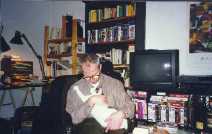 I finally retired at Johnıs. He also told me that his cat, Olga, was about
to give birth. Any day.
I finally retired at Johnıs. He also told me that his cat, Olga, was about
to give birth. Any day.
Friday, March seventh
I met Jean-Michel Nectoux at Radio France, of which he is director of
programming., much like his former position at the Musée
d'Orsay, a beautiful train station-turned-museum. We went to a local Chinese
restaurant and talked over a light meal.
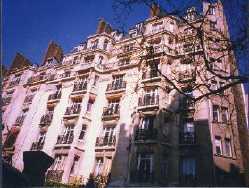 Afterwards, we walked to rue des Vignes where Fauré lived. On the way,
we passed Théatre du Ranelagh, the location of the first three rounds
of the 1984 Paris International Singing Competition.
Afterwards, we walked to rue des Vignes where Fauré lived. On the way,
we passed Théatre du Ranelagh, the location of the first three rounds
of the 1984 Paris International Singing Competition.
 At 32 rue des Vignes, M. Nectoux told me he did not know who
lived there now. I knew that he had tried singlehandedly to save it from being given
up and this was obviously, and understandably, a sad subject for him. He
told me a few things about the address, what the area was like in the
1920s.
At 32 rue des Vignes, M. Nectoux told me he did not know who
lived there now. I knew that he had tried singlehandedly to save it from being given
up and this was obviously, and understandably, a sad subject for him. He
told me a few things about the address, what the area was like in the
1920s.
Fauré's studio was located on the sixth floor (or cinqième étage).

This is the plaque on the front of the building. It reads: "In this house, in which he lived from the year 1911, Gabriel Fauré died on November 4, 1924."
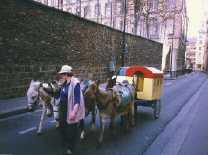
As we turned to go back to Radio France, a brightly-colored cart drawn by
four donkeys went by...
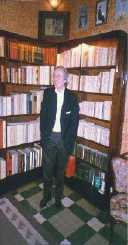 Then I visited my friend Marc Meynardie, an antique book dealer. He
doesn't speak English very well, I don't speak French very well so we
speak German.
Then I visited my friend Marc Meynardie, an antique book dealer. He
doesn't speak English very well, I don't speak French very well so we
speak German.
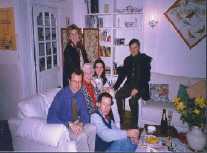 For dinner, I was invited to Tobé and Stephen Malawista's
apartment in the area called Isle St. Louis. While there,
Tobé called Madame Aitoff and arranged for me to talk with her on
Monday. In this picture are (left to right): Tobé Malawista, Richard
Lalli, Anita Marvin, Sandra Marvin, Stephen Malawista and Michael Rigsby.
For dinner, I was invited to Tobé and Stephen Malawista's
apartment in the area called Isle St. Louis. While there,
Tobé called Madame Aitoff and arranged for me to talk with her on
Monday. In this picture are (left to right): Tobé Malawista, Richard
Lalli, Anita Marvin, Sandra Marvin, Stephen Malawista and Michael Rigsby.
After champagne, we all walked along the Seihe,
me singing Poolenc's La Grenouillere in Tobéıs ear. We arrived at
Le Brasserie: I had the Paté du chef and Cassoulet (both very high in fat)
with red wine. Richard and Anita took care of everything here. They know how
to entertain.
We went back to Tobéıs for dessert which consisted of the exclusive
Bertillon sherbet, made and sold ONLY on the Isle St. Louis - I had
chocolate, almond, strawberry and mango. And then we were treated to the phenomenal voice of Anita Marvin, singing such light little tunes as Vissi d'arte and Ritorna vincitor!, with yours truly at the ivories. Tobé and Stephen gave me a Paris that I had never
experienced.
Saturday, March eighth
Since I had made plans to have lunch with the Selig family, I wanted
to pick up my traditional
Selig gift: a special cheese called Bouillon aux raisin. It can only be bought at
two markets in Paris so I went to the Villiers métro stop, made the
purchase and met Alison, Michael, Thomas, and Daniel at my métro station, Pyrenées. Then we
traveled to meet David. The minute the five of us boarded the métro, all
three boys got out their respective books and started reading. It was so impressive to see
young boys reading for pleasure.
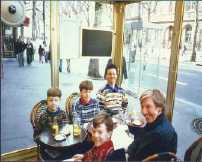 We went to a Selig family favorite restaurant near Palais Royale
where I had salad tomate, steak tartar and tarte aux poir. After lunch, David and
I walked to the music publisher, Le Duc to purchase some sheet music.
Unfortunately, they were closed.
We went to a Selig family favorite restaurant near Palais Royale
where I had salad tomate, steak tartar and tarte aux poir. After lunch, David and
I walked to the music publisher, Le Duc to purchase some sheet music.
Unfortunately, they were closed.
I then went back to chez Skippen where his cleaning man/cook/carpenter
from Sri Lanka named Stanley had prepared for us a delicious dinner of green
salad and a lamb curry with rice. We then made our way to the
Fauié Réquiem concert.
It was located on the Isle St. Louis. The program
consisted of a four-movement mass by Louis Niedermayer (Fauré's first teacher); then the most popular choral works of Fauré: the Cahtique deJean Raçine and the Réquiem. I was very curious to ascerttain which edition they
used, either the Nectoux edition (which I consider the only edition one should
use) or the fraudulent John Rutter edition (Mr. Rutter did not consult ANY of the
available manuscripts!). There were moments that told me it was Nectoux I was hearing, but sometimes it wasn't. I must mention that the soprano
soloist was an Asian soprano, a pupil of Isabelle Garcison, who is also
Tobéıs voice teacher. (I canıt locate her name); she sang the "Pié Jésu" beautifully and not trying to sing it like a boy (the boy soprano-later-
composer Louis Aubert sang the premiere).
Afterwards, John and I spoke with the conductor. John introduced me as
"a Fauré expert (!) from New York" and we asked her what edition she used.
Unfortunately for her, we discovered her sly ways. She had used the - cheaper -
Rutter edition without renting it; so, at least Mr. Rutter didn't make any
money with this concert.
We walked down the block to a local Bertillon stand and I had, believe
it or not, the two flavors of pohr (my favorite fruit - pear) and Earl Grey
tea flavor. It was divine.
Sunday, March ninth
Sunday was probably the best day, if there can be one, of my visit.
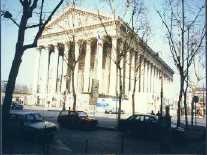 It began by attending service at the Church of the Maddeleine. Built by
Napoleon, it is a gargantuan Greek temple very much like the Parthenon, sitting on a huge slab of marble with six or more streets leading into it
from all directions.
It began by attending service at the Church of the Maddeleine. Built by
Napoleon, it is a gargantuan Greek temple very much like the Parthenon, sitting on a huge slab of marble with six or more streets leading into it
from all directions.
This was the church where Fauré was organist and choirmaster, where his
Réquiem was premiered and where his own funeral service was held. Just being inside
was a breath-taking experience.
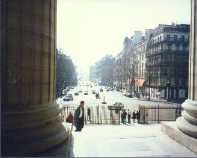 At the end of the service, the huge doors that face East were opened and
the church was filled with absolutely blazing spiritual sunlight. It was
magical. I then arranged to see the organ.
At the end of the service, the huge doors that face East were opened and
the church was filled with absolutely blazing spiritual sunlight. It was
magical. I then arranged to see the organ.

A priest showed me the doorway to the staircase
 I climbed up the spiral staircase to the organ loft.
I climbed up the spiral staircase to the organ loft.
The organist let me listen to the next service and even let me sit on
the bench. I was literally and figuratively in heaven (the loft was located
about four or more stories above the church floor). The organist
introduced himself with a long hyphenated name and I just said my name was Donald.
Then he said "et je m'appelle Mickey."

I then made photo stops at the old Paris Conservatoire where Fauré was
director,
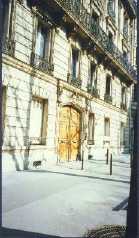
and at 154 Boulevard Malesherbes, another Fauré residence.
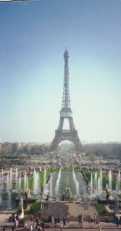 The next stop was the spectacular view from the Plaza Trocadéro of the
Eiffel Tower.
The next stop was the spectacular view from the Plaza Trocadéro of the
Eiffel Tower.
 My final stop was Passy Cemetery where Fauré is buried in the Frémiet tomb (his father-in-law was a rather famous sculptor of animals and
more well-known than Fauré during
Fauré's lifetime).
My final stop was Passy Cemetery where Fauré is buried in the Frémiet tomb (his father-in-law was a rather famous sculptor of animals and
more well-known than Fauré during
Fauré's lifetime).
 I had asked the concierge if it would be possible for me to make an
impression of the Fauré tomb. He said it was forbidden since the tomb
was the property of the Ministry of Culture, etc. etc.
I had asked the concierge if it would be possible for me to make an
impression of the Fauré tomb. He said it was forbidden since the tomb
was the property of the Ministry of Culture, etc. etc.
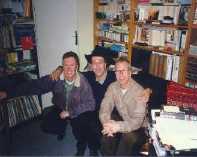 In late afternoon, John and I joined Mark Davies (an Australian
accompanist/pianist whom I met at the Munich Competition in 1984) and his
friend François Monnier, a history professor. We had champagne and
caught up personally. John and I then had dinner at Camille's.
In late afternoon, John and I joined Mark Davies (an Australian
accompanist/pianist whom I met at the Munich Competition in 1984) and his
friend François Monnier, a history professor. We had champagne and
caught up personally. John and I then had dinner at Camille's.
Monday, March tenth
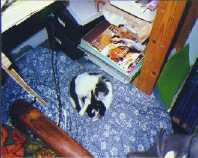 This morning at 2am, Olga gave birth to 3 kittens. I asked what color
they were and he said, with great disdain, "Black. And I think I know who the
father is."
This morning at 2am, Olga gave birth to 3 kittens. I asked what color
they were and he said, with great disdain, "Black. And I think I know who the
father is."
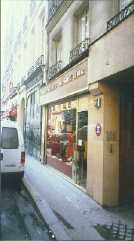 First on my list was the music publisher, Le Duc. I purchased a copy of
the piano/vocal score and pocket orchestral score of the Fauré Rçquiem in the
somewhat new Nectoux edition based on a set of parts dating from the premiere
found at the Maddeleine by Jean-Michel Nectoux. On my way home, I
stopped at a local boulangerie and had a quiche-like pizza and a tarte aux pohr.
First on my list was the music publisher, Le Duc. I purchased a copy of
the piano/vocal score and pocket orchestral score of the Fauré Rçquiem in the
somewhat new Nectoux edition based on a set of parts dating from the premiere
found at the Maddeleine by Jean-Michel Nectoux. On my way home, I
stopped at a local boulangerie and had a quiche-like pizza and a tarte aux pohr.
 Madame Irene Aitoff lives just on the edge of Paris where there are no
subways, so I had to take a taxi. She lives in a spacious, elegant
apartment with a beautifully-appointed studio that is filled with sunlight.
Madame Irene Aitoff lives just on the edge of Paris where there are no
subways, so I had to take a taxi. She lives in a spacious, elegant
apartment with a beautifully-appointed studio that is filled with sunlight.
Madame Aitoff, simply put, taught everything to just about everybody
who was anybody: she taught Pellé.as to von Karajan and Münch, a dozen opera
roles to Bacquier, was THE répetiteur at the Aix-en- Provençe Festival when it
was the most prestigious opera festival in the world, etc.
Many of the things that I had heard about her up until now, I must confess, I
did not believe. Well, I saw it with my own eyes:
She could play Pelléas completely from memory.
She could sing all roles perfectly while playing the score; and
by watching her eyes, I SAW Mélisande watch the ring she threw in the
air and follow it to the depths of the well.
It was an amazing two and a half hours, artistically fulfilling and
personally bittersweet at the same time. I sang the entire role of Pelléas for her
after having not sung a note for two years.
After all, I had studied this role for twenty years and more and thought I
knew a lot of all there is to know about the role; and yet she pointed out
one of the many wrong notes printed in the score that I had not known
about. Even though our meeting was about six years too late, I will still
cherish the experience, thanks to Tobé.
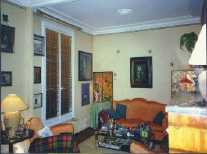 My friend Marc Meynardie cooked dinner for me at his new (to me)
apartment on the Boulevard Clichy, an area where Bizet lived and wrote
Carmen, Berlioz lived, etc. He fixed sliced lox on a pancake with creme
frâiche, broiled medallions of lamb with potatoes, green beans, red wine,
salad, a vanilla ice cream confection and camembert/bleu cheeses. His
apartment was beautifully decorated with all the walls tufted with
material.
My friend Marc Meynardie cooked dinner for me at his new (to me)
apartment on the Boulevard Clichy, an area where Bizet lived and wrote
Carmen, Berlioz lived, etc. He fixed sliced lox on a pancake with creme
frâiche, broiled medallions of lamb with potatoes, green beans, red wine,
salad, a vanilla ice cream confection and camembert/bleu cheeses. His
apartment was beautifully decorated with all the walls tufted with
material.
Tuesday, March eleventh
I decided to defy the concierge at Passy Cemetery, so I went to a big art
supply store called Rougiers et plé
and bought a large piece of paper,
scotch tape, a fixant spray, dark pink crayons and set off to
commit my crime.
 I stuffed the tube of paper down my trouser leg to hide it and walked in as
inconspicuous as I could. I even walked in a direction away from Fauré. I
was out of there with my impression in twenty minutes. Then I had lunch
at a swank Italian restaurant with Charles Fabius, an agent who heads the
Paris office of Opé
ra et Concerts. He filled me in on the European opera
scene.
I stuffed the tube of paper down my trouser leg to hide it and walked in as
inconspicuous as I could. I even walked in a direction away from Fauré. I
was out of there with my impression in twenty minutes. Then I had lunch
at a swank Italian restaurant with Charles Fabius, an agent who heads the
Paris office of Opé
ra et Concerts. He filled me in on the European opera
scene.
 For my last Fauré site, I located the Square Gabriel Fauré. It was rather insignificant, no reason for this square to be named for him.
For my last Fauré site, I located the Square Gabriel Fauré. It was rather insignificant, no reason for this square to be named for him.
I met John at the Bastille métro station and then we walked to
the Musée d'Orsay, to meet Mark Davies for a Maeterlinck concert. It was
prepared partly by M. Nectoux and was done very effectively with
great taste, performing music associated with the poet. The program opened
with a four-hand version of Fauréıs Pelléas et Mélisande suite, then
scenes from Debussy's Pelléas et Mélisande and Duka's Arianne et Barbe-bleu and songs by unknown composers.
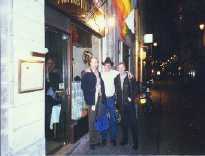 The three of us then met Frahçois at their apartment and we all went to
dinner at Au Trois Pétites Couchons (Three Little Pigs) for an elegant
meal. I had avocado and muscles in a cream sauce, roasted chicken, red
wine, crepe suzette and cherry liquer with cherries.
The three of us then met Frahçois at their apartment and we all went to
dinner at Au Trois Pétites Couchons (Three Little Pigs) for an elegant
meal. I had avocado and muscles in a cream sauce, roasted chicken, red
wine, crepe suzette and cherry liquer with cherries.
This was a wonderful trip to my beloved Paris and I will cherish all the
memories for a long time to come.

Return to The Raised Fourth
Go back to the HomePage
Fauré's studio was located on the sixth floor (or cinqième étage).
This is the plaque on the front of the building. It reads: "In this house, in which he lived from the year 1911, Gabriel Fauré died on November 4, 1924."
As we turned to go back to Radio France, a brightly-colored cart drawn by four donkeys went by...
After champagne, we all walked along the Seihe, me singing Poolenc's La Grenouillere in Tobéıs ear. We arrived at Le Brasserie: I had the Paté du chef and Cassoulet (both very high in fat) with red wine. Richard and Anita took care of everything here. They know how to entertain.
We went back to Tobéıs for dessert which consisted of the exclusive Bertillon sherbet, made and sold ONLY on the Isle St. Louis - I had chocolate, almond, strawberry and mango. And then we were treated to the phenomenal voice of Anita Marvin, singing such light little tunes as Vissi d'arte and Ritorna vincitor!, with yours truly at the ivories. Tobé and Stephen gave me a Paris that I had never experienced.
Saturday, March eighth
Since I had made plans to have lunch with the Selig family, I wanted
to pick up my traditional
Selig gift: a special cheese called Bouillon aux raisin. It can only be bought at
two markets in Paris so I went to the Villiers métro stop, made the
purchase and met Alison, Michael, Thomas, and Daniel at my métro station, Pyrenées. Then we
traveled to meet David. The minute the five of us boarded the métro, all
three boys got out their respective books and started reading. It was so impressive to see
young boys reading for pleasure.
 We went to a Selig family favorite restaurant near Palais Royale
where I had salad tomate, steak tartar and tarte aux poir. After lunch, David and
I walked to the music publisher, Le Duc to purchase some sheet music.
Unfortunately, they were closed.
We went to a Selig family favorite restaurant near Palais Royale
where I had salad tomate, steak tartar and tarte aux poir. After lunch, David and
I walked to the music publisher, Le Duc to purchase some sheet music.
Unfortunately, they were closed.
I then went back to chez Skippen where his cleaning man/cook/carpenter
from Sri Lanka named Stanley had prepared for us a delicious dinner of green
salad and a lamb curry with rice. We then made our way to the
Fauié Réquiem concert.
It was located on the Isle St. Louis. The program
consisted of a four-movement mass by Louis Niedermayer (Fauré's first teacher); then the most popular choral works of Fauré: the Cahtique deJean Raçine and the Réquiem. I was very curious to ascerttain which edition they
used, either the Nectoux edition (which I consider the only edition one should
use) or the fraudulent John Rutter edition (Mr. Rutter did not consult ANY of the
available manuscripts!). There were moments that told me it was Nectoux I was hearing, but sometimes it wasn't. I must mention that the soprano
soloist was an Asian soprano, a pupil of Isabelle Garcison, who is also
Tobéıs voice teacher. (I canıt locate her name); she sang the "Pié Jésu" beautifully and not trying to sing it like a boy (the boy soprano-later-
composer Louis Aubert sang the premiere).
Afterwards, John and I spoke with the conductor. John introduced me as
"a Fauré expert (!) from New York" and we asked her what edition she used.
Unfortunately for her, we discovered her sly ways. She had used the - cheaper -
Rutter edition without renting it; so, at least Mr. Rutter didn't make any
money with this concert.
We walked down the block to a local Bertillon stand and I had, believe
it or not, the two flavors of pohr (my favorite fruit - pear) and Earl Grey
tea flavor. It was divine.
Sunday, March ninth
Sunday was probably the best day, if there can be one, of my visit.
 It began by attending service at the Church of the Maddeleine. Built by
Napoleon, it is a gargantuan Greek temple very much like the Parthenon, sitting on a huge slab of marble with six or more streets leading into it
from all directions.
It began by attending service at the Church of the Maddeleine. Built by
Napoleon, it is a gargantuan Greek temple very much like the Parthenon, sitting on a huge slab of marble with six or more streets leading into it
from all directions.
This was the church where Fauré was organist and choirmaster, where his
Réquiem was premiered and where his own funeral service was held. Just being inside
was a breath-taking experience.
 At the end of the service, the huge doors that face East were opened and
the church was filled with absolutely blazing spiritual sunlight. It was
magical. I then arranged to see the organ.
At the end of the service, the huge doors that face East were opened and
the church was filled with absolutely blazing spiritual sunlight. It was
magical. I then arranged to see the organ.

A priest showed me the doorway to the staircase
 I climbed up the spiral staircase to the organ loft.
I climbed up the spiral staircase to the organ loft.
The organist let me listen to the next service and even let me sit on
the bench. I was literally and figuratively in heaven (the loft was located
about four or more stories above the church floor). The organist
introduced himself with a long hyphenated name and I just said my name was Donald.
Then he said "et je m'appelle Mickey."

I then made photo stops at the old Paris Conservatoire where Fauré was
director,

and at 154 Boulevard Malesherbes, another Fauré residence.
 The next stop was the spectacular view from the Plaza Trocadéro of the
Eiffel Tower.
The next stop was the spectacular view from the Plaza Trocadéro of the
Eiffel Tower.
 My final stop was Passy Cemetery where Fauré is buried in the Frémiet tomb (his father-in-law was a rather famous sculptor of animals and
more well-known than Fauré during
Fauré's lifetime).
My final stop was Passy Cemetery where Fauré is buried in the Frémiet tomb (his father-in-law was a rather famous sculptor of animals and
more well-known than Fauré during
Fauré's lifetime).
 I had asked the concierge if it would be possible for me to make an
impression of the Fauré tomb. He said it was forbidden since the tomb
was the property of the Ministry of Culture, etc. etc.
I had asked the concierge if it would be possible for me to make an
impression of the Fauré tomb. He said it was forbidden since the tomb
was the property of the Ministry of Culture, etc. etc.
 In late afternoon, John and I joined Mark Davies (an Australian
accompanist/pianist whom I met at the Munich Competition in 1984) and his
friend François Monnier, a history professor. We had champagne and
caught up personally. John and I then had dinner at Camille's.
In late afternoon, John and I joined Mark Davies (an Australian
accompanist/pianist whom I met at the Munich Competition in 1984) and his
friend François Monnier, a history professor. We had champagne and
caught up personally. John and I then had dinner at Camille's.
Monday, March tenth
 This morning at 2am, Olga gave birth to 3 kittens. I asked what color
they were and he said, with great disdain, "Black. And I think I know who the
father is."
This morning at 2am, Olga gave birth to 3 kittens. I asked what color
they were and he said, with great disdain, "Black. And I think I know who the
father is."
 First on my list was the music publisher, Le Duc. I purchased a copy of
the piano/vocal score and pocket orchestral score of the Fauré Rçquiem in the
somewhat new Nectoux edition based on a set of parts dating from the premiere
found at the Maddeleine by Jean-Michel Nectoux. On my way home, I
stopped at a local boulangerie and had a quiche-like pizza and a tarte aux pohr.
First on my list was the music publisher, Le Duc. I purchased a copy of
the piano/vocal score and pocket orchestral score of the Fauré Rçquiem in the
somewhat new Nectoux edition based on a set of parts dating from the premiere
found at the Maddeleine by Jean-Michel Nectoux. On my way home, I
stopped at a local boulangerie and had a quiche-like pizza and a tarte aux pohr.
 Madame Irene Aitoff lives just on the edge of Paris where there are no
subways, so I had to take a taxi. She lives in a spacious, elegant
apartment with a beautifully-appointed studio that is filled with sunlight.
Madame Irene Aitoff lives just on the edge of Paris where there are no
subways, so I had to take a taxi. She lives in a spacious, elegant
apartment with a beautifully-appointed studio that is filled with sunlight.
Madame Aitoff, simply put, taught everything to just about everybody
who was anybody: she taught Pellé.as to von Karajan and Münch, a dozen opera
roles to Bacquier, was THE répetiteur at the Aix-en- Provençe Festival when it
was the most prestigious opera festival in the world, etc.
Many of the things that I had heard about her up until now, I must confess, I
did not believe. Well, I saw it with my own eyes:
She could play Pelléas completely from memory.
She could sing all roles perfectly while playing the score; and
by watching her eyes, I SAW Mélisande watch the ring she threw in the
air and follow it to the depths of the well.
It was an amazing two and a half hours, artistically fulfilling and
personally bittersweet at the same time. I sang the entire role of Pelléas for her
after having not sung a note for two years.
After all, I had studied this role for twenty years and more and thought I
knew a lot of all there is to know about the role; and yet she pointed out
one of the many wrong notes printed in the score that I had not known
about. Even though our meeting was about six years too late, I will still
cherish the experience, thanks to Tobé.
 My friend Marc Meynardie cooked dinner for me at his new (to me)
apartment on the Boulevard Clichy, an area where Bizet lived and wrote
Carmen, Berlioz lived, etc. He fixed sliced lox on a pancake with creme
frâiche, broiled medallions of lamb with potatoes, green beans, red wine,
salad, a vanilla ice cream confection and camembert/bleu cheeses. His
apartment was beautifully decorated with all the walls tufted with
material.
My friend Marc Meynardie cooked dinner for me at his new (to me)
apartment on the Boulevard Clichy, an area where Bizet lived and wrote
Carmen, Berlioz lived, etc. He fixed sliced lox on a pancake with creme
frâiche, broiled medallions of lamb with potatoes, green beans, red wine,
salad, a vanilla ice cream confection and camembert/bleu cheeses. His
apartment was beautifully decorated with all the walls tufted with
material.
Tuesday, March eleventh
I decided to defy the concierge at Passy Cemetery, so I went to a big art
supply store called Rougiers et plé
and bought a large piece of paper,
scotch tape, a fixant spray, dark pink crayons and set off to
commit my crime.
 I stuffed the tube of paper down my trouser leg to hide it and walked in as
inconspicuous as I could. I even walked in a direction away from Fauré. I
was out of there with my impression in twenty minutes. Then I had lunch
at a swank Italian restaurant with Charles Fabius, an agent who heads the
Paris office of Opé
ra et Concerts. He filled me in on the European opera
scene.
I stuffed the tube of paper down my trouser leg to hide it and walked in as
inconspicuous as I could. I even walked in a direction away from Fauré. I
was out of there with my impression in twenty minutes. Then I had lunch
at a swank Italian restaurant with Charles Fabius, an agent who heads the
Paris office of Opé
ra et Concerts. He filled me in on the European opera
scene.
 For my last Fauré site, I located the Square Gabriel Fauré. It was rather insignificant, no reason for this square to be named for him.
For my last Fauré site, I located the Square Gabriel Fauré. It was rather insignificant, no reason for this square to be named for him.
I met John at the Bastille métro station and then we walked to
the Musée d'Orsay, to meet Mark Davies for a Maeterlinck concert. It was
prepared partly by M. Nectoux and was done very effectively with
great taste, performing music associated with the poet. The program opened
with a four-hand version of Fauréıs Pelléas et Mélisande suite, then
scenes from Debussy's Pelléas et Mélisande and Duka's Arianne et Barbe-bleu and songs by unknown composers.
 The three of us then met Frahçois at their apartment and we all went to
dinner at Au Trois Pétites Couchons (Three Little Pigs) for an elegant
meal. I had avocado and muscles in a cream sauce, roasted chicken, red
wine, crepe suzette and cherry liquer with cherries.
The three of us then met Frahçois at their apartment and we all went to
dinner at Au Trois Pétites Couchons (Three Little Pigs) for an elegant
meal. I had avocado and muscles in a cream sauce, roasted chicken, red
wine, crepe suzette and cherry liquer with cherries.
This was a wonderful trip to my beloved Paris and I will cherish all the
memories for a long time to come.

Return to The Raised Fourth
Go back to the HomePage
This was the church where Fauré was organist and choirmaster, where his Réquiem was premiered and where his own funeral service was held. Just being inside was a breath-taking experience.
A priest showed me the doorway to the staircase
The organist let me listen to the next service and even let me sit on the bench. I was literally and figuratively in heaven (the loft was located about four or more stories above the church floor). The organist introduced himself with a long hyphenated name and I just said my name was Donald. Then he said "et je m'appelle Mickey."
I then made photo stops at the old Paris Conservatoire where Fauré was director,
and at 154 Boulevard Malesherbes, another Fauré residence.
Monday, March tenth
Madame Aitoff, simply put, taught everything to just about everybody who was anybody: she taught Pellé.as to von Karajan and Münch, a dozen opera roles to Bacquier, was THE répetiteur at the Aix-en- Provençe Festival when it was the most prestigious opera festival in the world, etc.
Many of the things that I had heard about her up until now, I must confess, I did not believe. Well, I saw it with my own eyes:
She could play Pelléas completely from memory.
She could sing all roles perfectly while playing the score; and
by watching her eyes, I SAW Mélisande watch the ring she threw in the air and follow it to the depths of the well.
It was an amazing two and a half hours, artistically fulfilling and personally bittersweet at the same time. I sang the entire role of Pelléas for her after having not sung a note for two years.
After all, I had studied this role for twenty years and more and thought I knew a lot of all there is to know about the role; and yet she pointed out one of the many wrong notes printed in the score that I had not known about. Even though our meeting was about six years too late, I will still cherish the experience, thanks to Tobé.